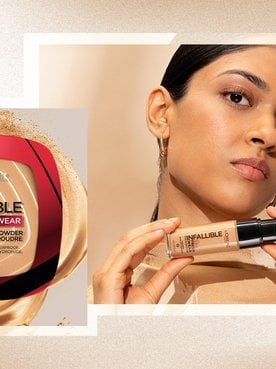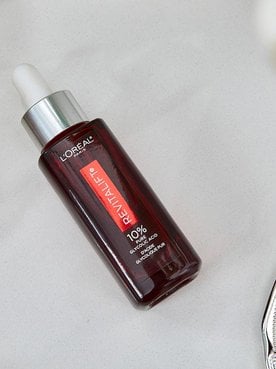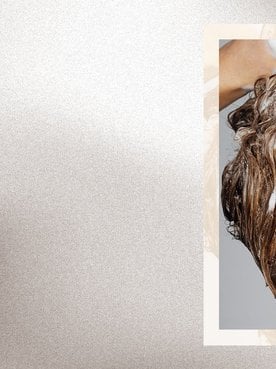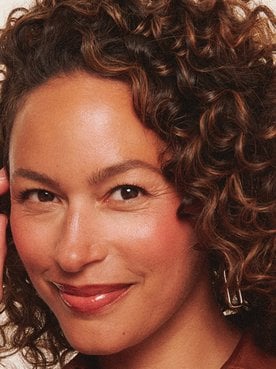In this article
Type “What is a beauty mark?” into your preferred search engine, and you’re likely to end up with more questions than answers. Some say the term can be used to describe any dark spot on the face; others insist the term “beauty mark” is simply another word for a small mole. Both answers can be true, depending on who you ask—no matter how you define it, though, beauty marks are often seen as a unique and desirable feature.
Still, if you have a beauty mark on your face, you may have questions about the different types of spots and what they mean. Ahead, we’ll share the details, offer insight into the difference between moles and beauty marks, and explain how to check your beauty marks and moles for changes that could warrant a visit with the dermatologist. Read on for all of the details.
What Is a Beauty Mark?
Beauty marks typically refer to the common mole, which, according to the American Academy of Dermatology (AAD), nearly every adult has. In fact, as the AAD notes, most adults have between 10 and 40 moles (if you have fair skin, you may have even more). Generally, these small spots develop within the first 20 years of life, per the Cleveland Clinic.
Mole vs. Beauty Mark: What’s the Difference?
Though most beauty marks are moles, not all moles are beauty marks. Here’s a quick breakdown of some ways the two spots may differ:
- Color: Beauty marks are typically dark brown to black. Moles, however, can be nearly any color from light pink to black—some even feature more than one color.
- Size and shape: Common moles, or beauty marks, are typically small and round. Other moles may be large or have an irregular shape (more on that shortly).
- Development: Beauty marks typically develop during childhood and darken during adolescence. Moles, meanwhile, can be present from birth.
- Location: Generally, the term “beauty mark” refers to a mole on the face. Moles can also develop on your arms, legs, chest, back, neck, or torso, but these are rarely referred to as beauty marks.
What Causes a Mole?
According to the Cleveland Clinic, moles develop when your skin’s pigment-producing cells grow in a cluster rather than being dispersed evenly throughout the skin. They can darken over time, often as a result of sun exposure or due to the hormonal fluctuations that occur during puberty or pregnancy. Common moles—in other words, beauty marks—are typically considered harmless. However, having more than 50 moles as an adult may indicate you have a higher risk of developing certain skin cancers, per the AAD.
3 Types Of Moles to Know
Common moles, or beauty marks, are only one type of mole. There are other types, too, including congenital moles and dysplastic moles. These two types of moles can develop into skin cancer, so it’s important to get them assessed by a board-certified dermatologist. Keep scrolling for a brief rundown on each type of mole.
Common moles
Common moles, sometimes referred to as common nevi, are what we typically mean when we’re talking about a beauty mark. They’re small, round, and are usually tan, brown, or black in color. Most of the time, they’re flat or very slightly raised, per the AAD.
Congenital moles
Congenital means “present from birth,” which means these moles are those you’re born with. They’re rarer than common moles, affecting roughly one in a hundred people. Congenital moles can vary in size from small to extremely large, and they may indicate a higher risk of developing melanoma (a type of skin cancer), according to the AAD.
Dysplastic moles
Dysplastic (also known as atypical) moles are large, irregularly shaped, and tend to be more than one color. Like congenital moles, dysplastic moles are often indicative of a higher skin cancer risk.
Why You Should Do Regular Mole Checks
The Cleveland Clinic explains that keeping track of your moles with regular checks increases the chance of being able to detect and treat melanoma and other types of skin cancers. So, when is a mole a concern, how can you keep tabs on them to ensure you aren’t at risk? Dermatologists recommend doing your own monthly check-ins to see if there are any changes in the color or appearance of your mole. In addition, it’s a good idea to ask your dermatologist for a full skin check once per year.
How To Do a Mole Check
Doing a mole check is pretty straightforward, but there are some tips to keep in mind.
1. Take a shower
For your monthly check-ins, it’s best to observe your skin right out of the shower or bath when it's still wet.
2. Stand in front of a mirror
Stand in front of a mirror to get a close, accurate view of your skin and moles. For those in areas that you can’t see with a full-length mirror, use a hand mirror, or enlist a trusted friend or relative for help.
3. Develop a system
Examine the same way each month. For example, work your way from head to toe each time you do a routine check-in and closely check for both new moles and changes in existing ones.
4. Don’t skip your toes
There are certain areas, like your toes, that you may not think to check for moles, but as we’ve mentioned, these spots can develop anywhere. Remember to check everywhere, including your toes, scalp, behind the ears, and even the soles of your feet.
5. Keep track
Taking pictures of your moles each month is a great way to stay on top of any changes that may have occurred. You can even date the pictures and store them in a folder so they’re easy to look back on.
What To Look for When Checking Your Moles
While checking your moles regularly is important, it’s essential to know what to look for. The ABCDE skin assessment is often considered the gold standard by dermatologists. When checking your moles, the AAD advises paying close attention to the following:
- A: Asymmetry. Common moles generally have a defined round shape. Both halves of the mole should be roughly identical.
- B: Border. Harmless moles usually have a clear, well-defined border. Blurriness or fuzziness could be an indication of certain types of skin cancer.
- C: Color. Common moles are usually all one color. If your mole is multiple colors, it may be a dysplastic mole.
- D: Diameter. Most common moles and beauty marks are on the smaller side. Moles larger than the diameter of a pencil eraser are often considered a red flag.
- E: Evolution. Healthy moles should stay consistent in size and shape over time. If you notice any changes, contact your dermatologist—a mole changing color, getting larger, or becoming a new shape can be a sign of skin cancer.
Should I Be Worried About My Beauty Marks?
Now that you know the answer to the question “Are beauty marks moles?” you may be wondering whether they’re something to be concerned about. The answer to that, unfortunately, isn’t all that straightforward. In general, if your beauty mark remains the same size, shape, and color over time, it’s not a concern. Any visible changes, however, require an urgent appointment with a board-certified dermatologist. Likewise, if your beauty mark begins to itch, bleed, or scab, contact your dermatologist as soon as possible—these symptoms could be a sign of skin cancer.
To help reduce your risk of developing skin cancer, the United States Food and Drug Administration (FDA) recommends limiting your time spent in the sun, wearing protective clothing, and applying a broad-spectrum sunscreen with an SPF of at least 15 every day. Here are a few of our favorite formulas:
L’Oréal Paris Bright Reveal Broad Spectrum SPF 50 Daily UV Lotion
If you have a hard time finding a facial sunscreen that feels comfortable enough for daily wear, give this lightweight option a try. The non-greasy formula absorbs quickly and leaves the skin feeling fresh and hydrated (and it won’t leave behind a white cast). Plus, it helps prime the skin for makeup, so you can streamline your morning routine.
L’Oréal Paris RevitaLift Triple Power Moisturizer SPF 30
Tackle the visible signs of aging and protect your skin with this daily-use moisturizer. The SPF 30 formula with pro-retinol, hyaluronic acid, and vitamin C helps reduce the appearance of wrinkles and leaves the skin looking firmer and brighter with consistent use.
L’Oréal Paris Wrinkle Expert 55+ Age Defense Lotion SPF
Smooth, strengthen, and protect your mature skin with this SPF 30 facial moisturizer. The gentle formula provides up to 24 hours of hydration and immediately leaves the skin looking refreshed and radiant. Use it every morning to help promote a more even, youthful-looking complexion.
L’Oréal Paris Collagen Filler Moisture Filler Moisturizer Broad Spectrum SPF 30
If you have oily skin, you may want to consider adding this SPF moisturizer to your routine. The lightweight formula provides up to 24 hours of hydration but feels incredibly lightweight on the skin. Plus, it boasts a semi-matte (never shiny) finish and layers well under makeup.
Can beauty marks and moles be removed?
Yes, many beauty marks and moles can be removed by a board-certified dermatologist. Sometimes, people opt to remove them for cosmetic reasons—in other words, because they simply don’t like the way the moles look. However, dermatologists may also remove moles that they think may develop into skin cancer in the future.
If you want to get a mole removed for cosmetic reasons, schedule an appointment with your dermatologist. They’ll be able to tell you if your mole can be removed, explain the different removal options, and go over the potential side effects of removal (such as scarring). The FDA strongly cautions against trying to remove beauty marks and moles at home—though some over-the-counter products are marketed for this purpose, none are FDA-approved, and they can be harmful to the skin.
How To Fake a Beauty Mark
As we mentioned earlier, beauty marks on the face are often considered a covetable feature. Fortunately, you don’t have to have a natural mole in order to get the look—you can easily fake a beauty mark with makeup (sort of like faux freckles).
If you want to draw on a beauty mark, all you need to do is grab a long-wearing pencil eyeliner (you don’t want it to smudge midday) and dot it onto your face. Try the L’Oréal Paris Infallible Pro-Last Waterproof, Up to 24HR Pencil Eyeliner in Brown. As for placement, whatever sparks joy in you should work just fine, but it’s popular to rock faux beauty marks under the eyes or near the lips. After you’re done, set the liner with powder and setting spray (such as the L’Oréal Paris Infallible 3-Second Setting Mist) to help ensure your faux mark holds up throughout the day.
Next Up: These Eye Creams Are the Answer to Your Pesky Dark Circles
Photo courtesy of L’Oréal Paris







